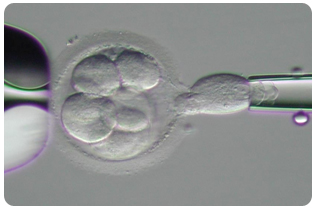 1. The Risk of Embryo Biopsy:
1. The Risk of Embryo Biopsy: While PGD is a relatively new procedure in IVF, the micromanipulation techniques required to perform it have been in use for many years. The risk of accidental damage to an embryo during removal of the cell(s) in the hands of an experienced embryologist is very low, and it is currently calculated at less than 1.0% Other Assisted Reproduction procedures such as Intracytoplasmic Sperm Injection (ICSI), Fragment Removal and Assisted Hatching are all performed by making microsurgical openings in the covering of the egg or embryo and none have been found to have other than mostly positive effects on implantation and viable pregnancy rates.
2. Removal of Cells from the Embryo: No part of the future fetus will be affected because one or two cells are removed from an embryo approximately two days after fertilization. At this develeopmental stage all cells in an embryo remain totipotent (until about the fourth day). These cells have not differentiated yet, meaning that each cell by itself can grow into a whole and perfect fetus. The biopsy procedure merely delays continued cell division for a few hours, after which the embryo reaches the same number of cells as before and continues its normal development. It is possible that embryo biopsy may lower embryo implantation rates slightly, while selection of chromosomally normal embryos via PGD may increase them. Therefore, the balance between potential biopsy damage and beneficial effects of PGD seems to be positive.
3. Misdiagnosis: The accuracy of PGD for aneuploidy is approximately 90%. This means that the error rate is 10%. Within this chance of misdiagnosis, there is a false negative rate, a false positive rate, the chance for no result and the chance for mosaicism. A mosaicism is defined as the embryo having cells with different chromosome make-up. Typically, all cells of the embryo have the same chromosomal make-up as they originate from the same fertilized egg. However, it is possible for cells of the same embryo to have differing numbers of chromosomes.
When the cell analyzed has a different chromosomal complement than all the others in the embryo a misdiagnosis occurs. Due to the chance of misdiagnosis as well as the presence of aneuploidies, for which testing is not available, we recommend prenatal testing as stated earlier.
4. No availability of embryos for transfer: In about 30% of couples, PGD testing will show that there are no normal embryos available for transfer. There are many reasons why this can occur. In some women, poor response to ovarian stimulation results in a low number of eggs and embryos. In others, despite production of an adequate number of embryos, the chromosome results are uniformly abnormal. Many problems are related to egg quality, while other factors such as sperm quality may also play a role in the number of abnormal embryos produced during an IVF cycle. In general, couples who do not produce normal embryos after two or three IVF/PGD cycles have a low chance of success in future cycles.